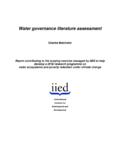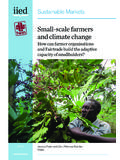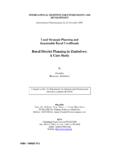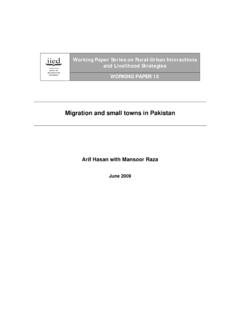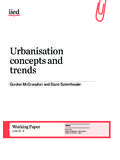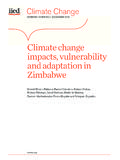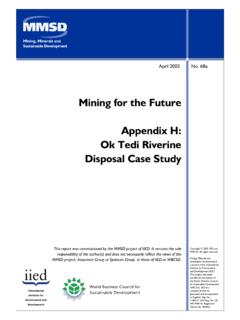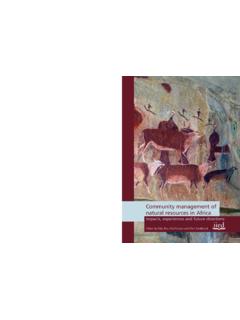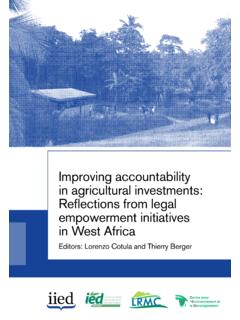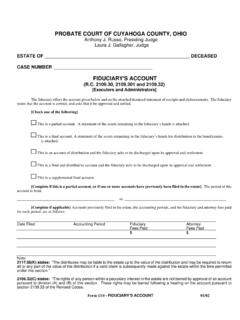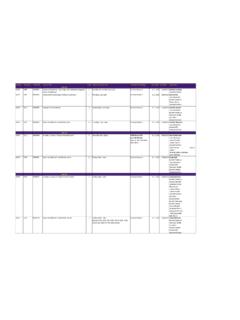Transcription of Agroecology - pubs.iied.org
1 AgroecologyWhat it is and what it has to offerLaura SiliciIssue PaperJune 2014 Food and agricultureKeywords: Agroecology , Small-scale farming, Food sovereignty, Agro-biodiversity About the authorsLaura Silici, Researcher, IIED Natural Resources Group, Agroecology team author is extremely grateful to Barbara Adolph, Krystyna Swiderska and Seth Cook (IIED) for their significant contributions to the draft; to Patrick Mulvany (UK Food Group) and Bruce Ferguson (El Colegio de la Frontera Sur) for reviewing the paper; and to Fiona Hinchcliffe for her valuable editorial advice. Produced by IIED s Natural Resources GroupThe aim of the Natural Resources Group is to build partnerships, capacity and wise decision-making for fair and sustainable use of natural resources.
2 Our priority in pursuing this purpose is on local control and management of natural resources and other by IIED, June 2014 laura Silici, 2014. Agroecology : What it is and what it has to offer . IIED Issue Paper. IIED, code: 14629 IIEDISBN : 978-1-78431- 065-3 Printed on recycled paper with vegetable-based credit: CIMMYT using Creative CommonsInternational Institute for Environment and Development 80-86 Gray s Inn Road, London WC1X 8NH, UK Tel: +44 (0)20 3463 7399 Fax: +44 (0)20 3514 9055 email: @iied more publications at a context of a changing climate and growing concerns for more healthy food systems, Agroecology is gaining momentum as a scientific discipline, sustainable farming approach and social movement.
3 There is growing anecdotal and case study evidence of its multiple benefits, from climate resilience to farm productivity. Yet its promotion in public agricultural policies, research and extension is still limited. This paper explores why this is. It calls for consolidating the evidence base for Agroecology through multi-dimensional tools that not only measure yields, but also its many other benefits: economic, environmental and social. Mainstreaming Agroecology will require a fundamental cultural and philosophical shift in how we as a society define productive and efficient agriculture. 3 ISSUE PAPERC ontentsSummary 41 What is Agroecology ?
4 6A science 7A set of practices 9A movement 102 What can Agroecology offer ? 12 Environmental sustainability, climate resilience and higher agro-biodiversity 13 Greater overall productivity, optimisation of yields and intensified sustainability 13 Livelihoods and food sovereignty 14A flexible toolkit 143 How can agroecological practices be more widely adopted? 16 Understand what drives farmers choices 17 Provide supportive policies and institutions 18 Build constructive complementarities between agroecological and conventional farming 204 Looking forward: consolidating the evidence for Agroecology 21 References 24 Notes 26 Agroecology | What it is and What it has to offer4 farming is coming of age.
5 Once the exclusive domain of food sovereignty and ecology movements, it has begun to be promoted enthusiastically in both developed and developing countries by non-government organisations, international development organisations and others seeking more sustainable food production and consumption systems. Though difficult to quantify, a growing body of anecdotal evidence and small-scale studies highlights the environmental and social benefits that these practices can bring. For example, a review of 40 initiatives employing different agroecological practices showed an average crop yield increase of 113%, in addition to environmental benefits such as carbon sequestration, reduction in pesticide use and soil Yet despite the fact that agroecological practices can bring resilience and broad-based productivity to rural communities and provide important ecosystem services across the landscape, they are still not being widely promoted in agricultural policies or by agricultural research organisations in developed nor developing countries, nor scaled-up at a significant level.
6 This paper asks why, tracing the multiple interpretations of Agroecology : what it means to different people and how it is used. It lists the benefits and challenges of agroecological practices and how they compare with input-intensive, large-scale farming. Finally, it asks what more needs to be done to mainstream Agroecology more widely in agricultural policies and practices? What is Agroecology ? Agroecology the application of ecological concepts and principles to the design and management of sustainable agro-ecosystems 2 has three facets. It is:1. a scientific discipline involving the holistic study of agro-ecosystems, including human and environmental elements2.
7 A set of principles and practices to enhance the resilience and ecological, socio-economic and cultural sustainability of farming systems3. a movement seeking a new way of considering agriculture and its relationships with can Agroecology offer ?A growing body of evidence reveals Agroecology s multiple advantages over conventional high-external input farming: a multi-functional approach to farming, capable of meeting environmental, economic and social needs greater environmental sustainability and resilience, especially in marginal areas subject to environmental degradation and extreme climatic events, and higher agrobiodiversity the ability to support farmers food sovereignty, reducing their dependence on costly and sometimes difficult-to-access chemical inputs higher overall productivity (at farm rather than crop level)
8 Achieved through a diverse range of agricultural products and environmental services, which reduce risks of crop failure in the long are the barriers to agroecological practicesbecoming more widespread? Agroecology is knowledge- and management-intensive. A common deterrent to its adoption is the large amount of soft inputs (such as knowledge and skills) and labour that some practices require in the initial seasons. Poorer and more marginal farmers, in particular, may decide not to adopt these practices if they do not have enough time and resources to invest in learning and experimentation. Policies and market signals are stacked against Agroecology .
9 The prices of conventional agricultural products are distorted by heavy subsidies both direct (such as farm and input subsides) and indirect (the health and environmental consequences of unsustainable practices that are paid for by taxpayers). Insecure land tenure and lack of access to natural resources can also inhibit the spread of Agroecology by discouraging farmers from adopting practices that require long-term investment in land and other | What it is and What it has to offeriied i ssue paper 5 Agroecology is viewed as alternative and sometimes in direct opposition to conventional farming. Yet the differences are often blurred.
10 Emphasising the two approaches as mutually-exclusive may undermine the constructive search for more common needs to be done? Consolidate the evidence base to support Agroecology through multi-dimensional analyses that provide comparable measures not just of crop yields, but also non-commodity outputs, such as feed available for livestock, mulching crops, provision of ecosystem services and contributions to the incomes and resilience of farming households. Promote a fundamental cultural and philosophical shift in the evaluation of what is regarded as productive and efficient , not just by farmers, but by society as a whole. The emphasis should be on optimising rather than maximising production (and profits).
